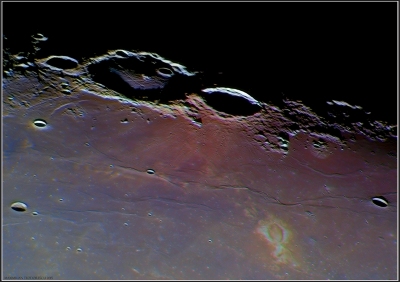A lunar imaging session under good seeing conditions, with some very good moments, despite the low temperatures (-4 degrees Celsius). The following images were acquired with the 14 inch F/5 homemade Newtonian working at F/20 and F/25 and the ASI120MM-S camera with a Baader Red filter for the grayscale images, and RGB filters for the color versions.
First image shows crater Pythagoras near the terminator with the impressive central peaks:
A detail from the above image, reprocessed and resized to 130%:
 A wide view image showing the western regions including Rimae Sirsalis to the left, crater Grimaldi at center on the terminator, with the floor mostly in darkness, crater Hevelius to the North (right on the image) with many rilles on the floor, crater Cavalerius Noth of Hevelius, and the Reiner Gamma formation towards lower right on the image.
A wide view image showing the western regions including Rimae Sirsalis to the left, crater Grimaldi at center on the terminator, with the floor mostly in darkness, crater Hevelius to the North (right on the image) with many rilles on the floor, crater Cavalerius Noth of Hevelius, and the Reiner Gamma formation towards lower right on the image.
The Hevelius-Cavalerius-Reiner Gamma part of the above mosaic was also acquired in the Green and Blue filters, allowing for an RGB color version of the area. Note the very different colors in the image, and especially the Reiner Gamma tones:
Another interesting formation, this time towards the South-West, crater Wargentin with an uplifted lava floor:
 Another well-known lunar crater, Gassendi, with a lot of rilles inside and near-by:
Another well-known lunar crater, Gassendi, with a lot of rilles inside and near-by:
 And the last formation imaged, Vallis Schroteri with crater Aristarchus (the brightest in the image) well depicted under this illumination. Notice the smaller rille inside Vallis Schroteri, and the many other smaller rilles towards north-east (lower right) from Aristarchus. Notice also the many terraces inside Aristarchus.
And the last formation imaged, Vallis Schroteri with crater Aristarchus (the brightest in the image) well depicted under this illumination. Notice the smaller rille inside Vallis Schroteri, and the many other smaller rilles towards north-east (lower right) from Aristarchus. Notice also the many terraces inside Aristarchus.
I’ve also acquired an RGB series of this region, and the final color image shows a lot more interesting details, especially the very well defined plateau on which Aristarchus and Vallis Schroteri are placed:






One Reply to “High Resolution lunar images – October 25, 2015”